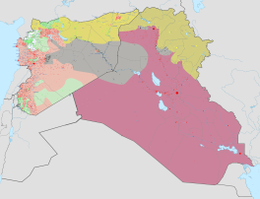Jihadism

| Part of a series on |
| Jihadism |
|---|
|
|
Jihadism (also jihadist movement or jihadi movement) refers to the renewed focus on armed jihad in Islamic fundamentalism since the later 20th century, but with a continuous history reaching back to the early 1800s (see Fula jihads).
"Jihadism" in this sense covers both Mujahideen guerilla warfare and Islamic terrorism with an international scope as it arose from the 1980s, since the 1990s substantially represented by the al-Qaeda network. It has its roots in the late 19th and early 20th century ideological developments of Islamic revivalism, developed into Qutbism and related ideologies during the mid 20th century. The rise of jihadism was re-enforced by the Soviet invasion of Afghanistan in 1979, and has been propagated in various armed conflicts throughout the 1990s and 2000s. A specifically Salafist jihadism has been diagnosed within the modern Salafi movement by Gilles Kepel in the mid-1990s.
Jihadism with an international, Pan-Islamist scope in this sense is also known as Global Jihadism. Generally the term jihadism denotes Sunni Islamist armed struggle. Sectarian tensions led to numerous forms of (Salafist and other Islamist) jihadism against Shia, Sufi and Ahmadi mosques.
Terminology
The original meaning of jihad in Arabic is literally "struggle" Although the adjective jihadist can be traced to the 1960s, and the abstract jihadism to ca. 1980, these terms did not see frequent use in popular media until after the 9/11 attacks of 2001. The equivalent terms of "jihadist movement" and "jihadi movement" date to the same period, entering use during the 1970s. The term "jihadism" translates or parallels Arabic jihādiyya جهادية. The alternative form jihadi for jihadist in English usage is a transliteration of the corresponding Arabic adjective jihādī جهادي.
According to Martin Kramer the term jihadism first became common in "the Indian and Pakistani media". "At present, jihadism is used to refer to the most violent persons and movements in contemporary Islam, including al-Qaeda." The term jihadism may also have been influenced by the term "jihadist-Salafism", put into "academic circulation" by "French academics".[1] Brachman in his Global jihadism (2008) concedes that the term is "clumsy and controversial".[2]
The term "Jihadist Globalism" is also often used in relation to Jihadism; according to Manfred Steger of RMIT University, the term "Jihadist Globalism" can apply to all extremely violent strains of religiously influenced ideologies that articulate the global imaginary into concrete political agendas and terrorist strategies. The term does not have to be specific to the Muslim society. Thus, the label could also apply to violent Christians in the West that strive to make a Christian Empire.[clarification needed][3]
Jihad Cool is term used by Western security experts[4] concerning the re-branding of militant Jihadism into something fashionable, or "cool", to younger people through social media, magazines,[5] rap videos,[6] clothing,[7] toys, propaganda videos,[8] and other means.[9] It is a sub-culture mainly applied to individuals in developed nations who are recruited to travel to conflict zones on Jihad. For example Jihadi rap videos make participants look "more MTV than Mosque", according NPR, which was the first to report on the phenomenon in 2010.[4][10]
Jihad fi sabilillah

In Islam, the phrase al-jihad fi sabilillah is the equivalent of the western notion of bellum justum or just war.[11] Such a "just war" or "war in the cause of Allah" has been propagated in modern fundamentalism beginning in the late 19th century, an ideology that arose in context of struggles against colonial powers in North Africa in the late 19th century, as in the Mahdist War in Sudan, and notably in the mid-20th century by Islamic revivalist authors such as Sayyid Qutb and Abul Ala Maududi.[12]
Based on this, the phrase is used in modern jihadism. Thus, "Fi Sabilillah" armbands were worn by rebels in Xinjiang when battling Soviet forces,[13] and the phrase has been spotted on flags used by jihadists in Caucasia in the 2000s.
Inter-religious
Against Sikhs
A rebel camp was set up in the early 19th century by Sayyid Ahmed Barelvi after leaving India for Afghanistan. There he set up a rebel camp to launch attacks against the Sikh power which was centered in the Punjab before focusing his attention of the British.[14] Waliullah's teachings directly inspired jihad against Sikhs between 1826 and 1831.[15]
Against Hindus
The Hindu Kush refers to a region in Northwest India and translates as the slaughter of the Hindus. It refers to an incident when Hindus were transported to Muslim courts.[16] Aurangzeb supervised a book called Fatawa al-Hindiyya which dealth with the subject of Jihad.[17] Jihad was also considered by SIMI in response to the 2002 Gujarat riots.[18]
Against Buddhists
In 1532, Sultan Said Khan launched a jihad against Tibetan Buddhists. He thought that Lhasa was a direction of prayer for all the Chinese and therefore sought to destroy its main temple. The jihadist expedition was led by Mirza Muhammad Haidar Dughlat.[19]
Against Jews
There are references in some hadiths to jihad being launched against Jews.[20] Ayman al-Zawahiri declared a fatwa of jihad against Jews in 1998. One of the earliest Jihads against Jews occurred in 627 AD against the Jewish Banu Qurayza tribe.[21]
Against Zoroastrians
During the Muslim conquest of Persia, Jihadists caused the fall of the largely Zoroastrian Sasanian Empire. Major battles included the Battle of al-Qādisiyyah and Battle of Nahāvand.[22][23]
Against pagans
During Muhammad's lifetime, there were many jihads launched against pagans including inside Mecca. Examples of jihad against pagans where prophet Muhammad participated include the Battle of Badr and Battle of the Trench.[24]
Against atheists

During the Soviet-Afghan war in the 1980s, many Muslims received calls for a jihad against atheists.[25] Mujahideen were recruited from various countries including Egypt, Pakistan, and Saudi Arabia.[26] The conflict gradually turned from one against occupation to one seen as a jihad.[27]
Against Christians
The European crusaders re-conquered much of the territory seized by the Islamic state, dividing it into four kingdoms, the most important being the state of Jerusalem. The Crusades originally had the goal of recapturing Jerusalem and the Holy Land (former Christian territory) from Muslim rule and were originally launched in response to a call from the Eastern Orthodox Byzantine Empire for help against the expansion of the Muslim Seljuk Turks into Anatolia. There was little drive to retake the lands from the crusaders, save the few attacks made by the Egyptian Fatimids. This changed, however, with the coming of Zangi, ruler of what is today northern Iraq. He took Edessa, which triggered the Second Crusade, which was little more than a 47-year stalemate. The stalemate was ended with the victory of Salah al-Din al-Ayyubi, known in the west as Saladin, over the forces of Jerusalem at the Horns of Hattin in 1187. It was during the course of the stalemate that a great deal of literature regarding Jihad was written.[6] While amassing his armies in Syria, Saladin had to create a doctrine which would unite his forces and make them fight until the bitter end, which would be the only way they could re-conquer the lands taken in the First Crusade. He did this through the creation of Jihad propaganda. It stated that any one who would abandon the Jihad would be committing a sin that could not be washed away by any means. It also put his amirs at the center of power, just under his rule. While this propaganda was successful in uniting his forces for a time, the fervor burned out quickly. Much of Saladin's teachings were rejected after his death.
Intra-religious
Against Shia
The Syrian Civil War has been a focal point for Sunni fighters waging jihad on Shia. The al-Nusra Front is the largest jihadist group in Syria.[28] The Muslim Brotherhood in Egypt has called for jihad against the Syrian government and its Shi'ite allies.[29] Saudi Arabia backs the jihad against the Shia in Syria using proxies.[30] Sunni jihadi converge in Syria from Saudi Arabia, Bahrain, Yemen, Kuwait, Tunisia, Libya, Egypt, Morocco, Jordan, Bosnia, other Arab states, Chechnya, Pakistan, Afghanistan and Western countries.[31]
History
This section needs expansion. You can help by adding to it. (March 2013) |

When jihadism is specifically motivated by Pan-Islamism, i.e. the ultimate aim of spreading Islam worldwide under a restored Caliphate, it is often called "Global Jihadism". But jihadism can also be motivated regionally, in an attempt to establish an Islamic state in a specific homeland. Global Jihadism is usually involved with international Islamic terrorism, while regional jihadism takes the form of guerrilla warfare, possibly also paired with terrorist attacks.
While the western term and concept of "jihadism" developed during the later half of the 20th century, this type of Islamist armed uprising against a secular government goes back to the early 19th century. The transition of this form of guerilla warfare was the decline of the great Muslim empires of the Early Modern period which could wage war on the scale of a great power and did not need to rely on asymmetric warfare (see Ottoman wars in Europe, Russo-Turkish War (1877–78), Dissolution of the Ottoman Empire). Early jihadist conflicts include:
- Fulani War (1804–1810)
- Padri War (1821–1838)
- Java War (1825–1830)
- Caucasus War (1828–1859)

The Fulani jihad states of West Africa, c. 1830 - Algerian resistance movement (1832 - 1847)
- Mahdist War (1881–1899)
- Somali Dervishes (1896–1920)
- Moro Rebellion (1899–1913)
- Aceh War (1873–1913)
- Basmachi Movement (1916–1934)
- Libyan resistance movement (1911–1943)
Modern Islamism developed in the 1920s, and there have been a number of armed "jihads" informed by this movement since then.
- Kumul Rebellion (1931–1934)
- Islamic rebellion in Xinjiang (1937)
- Insurgency in the Philippines (1969–present)
- Arakan rebellion (1978)
While the "jihads" waged in the 19th and early-to-mid 20th century occasionally did involve western colonial powers, the phenomenon did remain mostly limited to the Middle East and the wider Muslim World. This changed significantly with the foundation of the state of Israel and the beginning of the Arab–Israeli conflict after the end of World War II. (Islamic Jihad Movement in Palestine 1981–present, Islamic Jihad Organization 1982-1993, Hamas 1987–present). This sparked the beginning of international Islamic terrorism and put "jihadism" on the global agenda.
Islamic revivalism

The "modern" phase of Jihadism can be taken to span the 1990s to present.
- Kashmir conflict (Lashkar-e-Taiba, 1990–present)
- Somali Civil War (1991–present)
- Bosnian war (Bosnian mujahideen, 1992–1995)
- Afghan civil war (Taliban 1994–present)
- East Turkestan irredentism (East Turkestan Islamic Movement, 1997–present)
- Chechen war and Insurgency in the North Caucasus (Arab Mujahideen in Chechnya, 1994–present)
- Nigerian Sharia conflict (Boko Haram 2001–present)
- Iraqi insurgency (Islamic State of Iraq, 2003–present)
- Al-Qaeda insurgency in Yemen (Abyan Governorate, 2010–present)
- Syrian civil war (Al-Nusra Front to Protect the Levant 2011–present)
Jihadism has been called an "offshoot" of Islamic revivalism of the 1960s and 1970s. The writings of Sayyid Qutb and Muhammad abd-al-Salam Faraj provide inspiration. The Soviet war in Afghanistan (1979–1989) is said to have "amplified the jihadist tendency from a fringe phenomenon to a major force in the Muslim world.[32] It served to produce foot soldiers, leadership and organization. Abdullah Yusuf Azzam provided propaganda for the Afghan cause. After the war veteran jihadists returned to their home countries and dispersed to other sites of Muslim insurgency such as Algeria, Bosnia and Chechnya creating a "transnational jihadist stream."[33]
See also
- Islam and war
- Black flag of jihad
- Defensive jihad
- Caucasus Emirate,[34] a Salafist-takfiri jihadist group in Russia's North Caucasus
- Hezbollah, a Shi'ite armed movement not involved in the jihadism as defined.
- Islamic fundamentalism
- Islamic terrorism
- Mujahideen
- Offensive jihad
- Qutbism
- Salafist jihadism
- Sexual jihad
References
- ^ Martin Kramer (Spring 2003). "Coming to Terms: Fundamentalists or Islamists?". Middle East Quarterly. X (2): 65–77.
- ^ Brachman 2008, p. 4: "Jihadism is a clumsy and controversial term."
- ^ Steger, Manfred B. Globalization: A Short Introduction. 2009. Oxford University Publishing
- ^ a b Laura Italiano (June 20, 2014). "American Muslims flocking to jihadist group". New York Post. Retrieved August 22, 2014.
- ^ Steve Emerson (April 15, 2013). "Jihad is Cool: Jihadist Magazines Recruit Young Terrorists". Family Security Matters. Retrieved August 22, 2014.
- ^ J. Dana Stuster (April 29, 2013). "9 Disturbingly Good Jihadi Raps". Foreign Policy. Retrieved August 22, 2014.
- ^ Robert Spencer (August 7, 2014). "India: Imam arrested for distributing Islamic State t-shirts". Jihad Watch. Retrieved August 22, 2014.
- ^ Jytte Klausen (2012). "The YouTube Jihadists: A Social Network Analysis of Al-Muhajiroun's Propaganda Campaign". Perspectives on Terrorism. 6 (1). Retrieved August 22, 2014.
- ^ Cheryl K. Chumley (June 27, 2014). "Terrorists go 'Jihad Cool,' use rap to entice young Americans". Washington Times. Retrieved August 22, 2014.
- ^ Dina Temple-Raston (March 6, 2010). "Jihadi Cool: Terrorist Recruiters' Latest Weapon". National Public Radio. Retrieved August 22, 2014.
- ^ Rudolph Peters, Jihad in modern terms: a reader 2005, p. 120.
- ^ Rudolph Peters, Jihad in modern terms: a reader 2005, p. 107 and note p. 197. John Ralph Willis, "Jihad Fi Sabil Allah", in: In the path of Allah: the passion of al-Hajj ʻUmar : an essay into the nature of charisma in Islam, Routledge, 1989, ISBN 978-0-7146-3252-0, 29-57. "Gibb [Mohammedanism, 2nd ed. 1953] rightly could conclude that one effect of the renewed emphasis in the nineteenth century on the Qur'an and Sunna in Muslim fundamentalism was to restore to jihad fi sabilillah much of the prominence it held in the early days of Islam. Yet Gibb, for all his perception, did not consider jihad within the context of its alliance to ascetic and revivalist sentiments, nor from the perspectives which left it open to diverse interpretations." (p. 31)
- ^ Andrew D. W. Forbes (1986). Warlords and Muslims in Chinese Central Asia: a political history of Republican Sinkiang 1911-1949. Cambridge, England: CUP Archive. p. 144. ISBN 0-521-25514-7. Retrieved 2010-06-28.
- ^ Landscapes of the Jihad: Militancy, Morality, Modernity - Page 36
- ^ Partisans of Allah: Jihad in South Asia - Page 57, Ayesha Jalal - 2009
- ^ Islamic Economics and the Final Jihad David J. Jonsson - 2006 - Page 87
- ^ Understanding Jihad, David Cook - 2005, r 49
- ^ Islamism and Democracy in India, p 147, Irfan Ahmad - 2009
- ^ Buddhism and Islam on the Silk Road - Page 174, Johan Elverskog - 2011 -
- ^ Sahih Muslim 41:6985, Sahih Muslim 41:6981, Sahih Muslim 41:6982
- ^ Guillaume, Alfred, The Life of Muhammad: A Translation of Ibn Ishaq's Sirat Rasul Allah. Oxford University Press, 1955
- ^ Iranian History and Politics: The Dialectic of State and Society By Homa Katouzian, pg. 25
- ^ The Expansion of the Saracens-The East, C.H. Becker, The Cambridge Medieval History:The Rise of the Saracens and the Foundation of the Western Empire, Vol. 2, ed. John Bagnell Bury, (MacMillan Company, 1913), 348.
- ^ Donner, Narratives of Islamic Origins: The Beginnings of Islamic Historical Writing, p. 132.
- ^ The Far Enemy: Why Jihad Went Global - Page 68, Fawaz A. Gerges - 2009 -
- ^ Aging Early: Collapse of the Oasis of Liberties - Page 47, Mirza Aman - 2009
- ^ Withdrawing Under Fire, Joshua L. Gleis - 2011
- ^ "Inside Jabhat al Nusra – the most extreme wing of Syria's struggle". 2 December 2012.
- ^ Maggie Fick (June 14, 2013). "Egypt Brothers backs Syria jihad, slams Shi'ites". Reuters.
- ^ Robert F. Worth (Jan 7, 2014). "Saudis Back Syrian Rebels Despite Risks". New York Times.
- ^ Mark Hosenball (May 1, 2014). "In Iraq and Syria, a resurgence of foreign suicide bombers". The Economist.
- ^ Commins, David (2009). The Wahhabi Mission and Saudi Arabia. I.B.Tauris. p. 174.
- ^ Commins, David (2009). The Wahhabi Mission and Saudi Arabia. I.B.Tauris. pp. 156, 7.
- ^ Darion Rhodes, Salafist-Takfiri Jihadism: the Ideology of the Caucasus Emirate, International Institute for Counter-Terrorism, March 2014
Literature
- Abbas, Tahir (2007). Islamic Political Radicalism: A European Perspective. Edinburgh University Press. ISBN 978-0-7486-2528-4.
- Akbarzadeh, Shahram (2010). Islam and Political Violence: Muslim Diaspora and Radicalism in the West. I B Tauris & Co Ltd. ISBN 978-1-84511-473-2.
- Al-Rasheed, Madawi (2009). Dying for Faith: Religiously Motivated Violence in the Contemporary World. I B Tauris & Co Ltd. ISBN 978-1-84511-687-3.
- Aslan, Reza (2010). Global Jihadism. ISBN 978-3-639-25006-0.
- Gilles Kepel, Jihad: The Trail of Political Islam (2000, 2002, 2006).
- Brachman, Jarret (2008). Global jihadism: theory and practice. vol. 10 of Cass series on political violence, Taylor & Francis. ISBN 978-0-415-45241-0.
{{cite book}}: Invalid|ref=harv(help)*The Devolution of Jihadism: From Al Qaeda to Wider Movement. Stratfor. 2010. ISBN 978-1-4537-4664-6. - Coolsaet, Rik (2008). Jihadi Terrorism and the Radicalisation Challenge in Europe. Ashgate. ISBN 978-0-7546-7217-3.
- Hegghammer, Thomas (2010). Jihad in Saudi Arabia: Violence and Pan-Islamism since 1979. Cambridge University Press. ISBN 978-0-521-51858-1.
- Khosrokhavar, Farhad (2009). Inside Jihadism: Understanding Jihadi Movements Worldwide. Paradigm. ISBN 978-1-59451-616-0.
- Lahoud, Nelly (2010). The Jihadis' Path to Self-destruction. C Hurst & Co Publishers Ltd. ISBN 978-1-84904-062-4.
- Lohlker (ed.), Rüdiger (2013). Jihadism: Online Discourses and Representations. Vienna University Press. ISBN 978-3-8471-0068-3.
{{cite book}}:|last=has generic name (help)
- Lohlker (ed.), Rüdiger (2012). New Approaches to the Analysis of Jihadism. Vienna University Press. ISBN 978-3-89971-900-0.
{{cite book}}:|last=has generic name (help)
- Malik, S. K. (1986). The Quranic Concept of War (PDF). Himalayan Books. ISBN 81-7002-020-4.
- Pargeter, Alison (2008). The New Frontiers of Jihad: Radical Islam in Europe. I B Tauris & Co Ltd. ISBN 978-1-84511-391-9.
- Ranstorp, Magnus (2009). Understanding Violent Radicalisation. Routledge. ISBN 978-0-415-55630-9.
- Rhodes, Darion (2014). Salafist-Takfiri Jihadism: the Ideology of the Caucasus Emirate. International Institute for Counter-Terrorism.
- Sageman, Marc (2008). Leaderless Jihad: Terror Networks in the Twenty-first Century. University of Pennsylvania Press. ISBN 978-0-8122-4065-8.
- Sanchez, James (2007). Who's Who in Al-Qaeda & Jihadi Movements in South and Southeast Asia 19,906 Key Individuals, Organizations, Incidents, and Linkages. Lulu. ISBN 978-1-4303-1473-8.
- Vertigans, Stephen (2007). Militant Islam: A Sociology of Characteristics, Causes and Consequences. Routledge. ISBN 978-0-415-41246-9.

